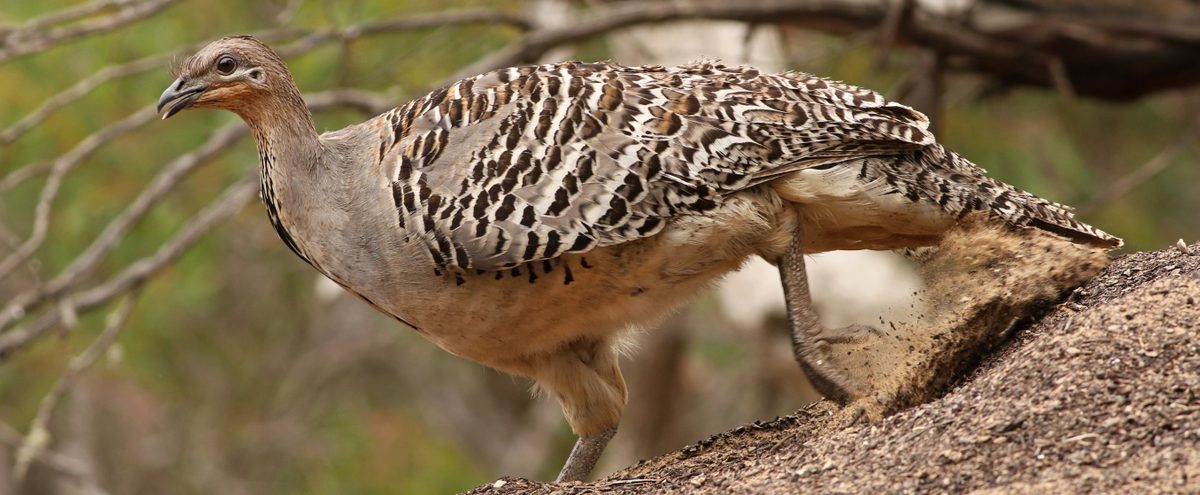
Malleefowl

Malleefowl (Leipoa ocellata) are shy, ground-dwelling birds and are Australia’s largest megapodes. These fascinating birds are best known for their massive nesting mounds.
Malleefowl are about the size of a large chicken with mostly pale grey-brown plumage, barred upperparts and a black marking down the throat. Males are a little larger than the females, but they are otherwise very similar. The male booms loudly and both sexes grunt and warble. Despite their size, malleefowl are well camouflaged and rarely seen. They have strong legs for digging and scraping in soil and litter for their nesting mounds.
The males build the mounds by piling up soil and leaf litter to create a compost heap that generates heat – nature’s very own incubator! The female then lays an egg every 5 to 7 days until the end of summer – they can lay up to 30 eggs in one season!
Instead of sitting on the eggs, the male carefully monitors the mound’s temperature with his beak, and then controls it by adding or removing material. Once the chicks hatch underground (usually one at a time), they dig their way to the surface all by themselves, and from that point on, they’re totally on their own.
The malleefowl diet changes depending on the season and location. Typically, they feed on a variety of flowers, fruits, seeds, herbs, invertebrates, fungi and tubers. During breeding season, a diet high in protein and energy foods, such as Acacia seeds and lerps, is important as it increases survival chances for chicks.
Where do malleefowl live?
Malleefowl live in dry, sandy country covered in mallee vegetation, mostly across southern Australia. They occupy semi-arid to arid shrublands and woodlands but are found mainly in mallee woodland habitat that has not recently been burnt. The Murraylands and Riverland region is one of the best places in Australia to find them.
Malleefowl use roadside vegetation to relocate to other patches of scrub. Chicks can disperse at an average rate of 600 m per day when newly hatched and up to 2 km for adults. Breeding malleefowl have an average home range between 83 and 92 ha, and are tightly bound to their nesting mounds. This area is 6 times larger for non-breeding birds.
Why are malleefowl threatened?
Malleefowl are listed as vulnerable to extinct nationally. Their main threat is habitat loss - first through widespread land clearing, and now through ongoing degradation and fragmentation. This includes changes in vegetation, reduced food availability, grazing pressure, invasive species, and small, disconnected patches of habitat.
The biggest threat to habitat condition for malleefowl is grazing. Malleefowl rely on seeds, flowers and fresh green plant growth for a big part of their diet, so they are in direct competition with many herbivores including feral goats, feral rabbits and over-abundant kangaroo species. Over grazed habitat also lacks the leaf litter required to generate heat through decomposition in their mounds to incubate their eggs. It also lacks protective cover which exposes them to predators.
Changes in climate are also impacting the native vegetation which is in turn affecting the malleefowl. Foxes and cats can prey on eggs, chicks and adults while feral goats and deer can trample their nests.
What is being done to help malleefowl?
Current management strategies for malleefowl include the fencing of areas of habitat to keep out stock controlling feral deer, goats, rabbits and foxes, undertaking monitoring surveys and captive breeding programs. In large conservation reserves that used to be pastoral grazing properties, we are removing the now redundant stock-water points which reduces herbivore populations. For more information on malleefowl monitoring and how you can get involved, head to our FLOW page.
Help save malleefowl
You can help the malleefowl by:
- Being a responsible pet owner – desex your cats and dogs, keep them inside at night and don’t take them into national parks.
- Avoiding taking firewood from malleefowl habitat areas.
- Joining a conservation group to help look after malleefowl habitat.
- Landholders should continue to fence habitat, and look to develop integrated control of rabbits, feral goats, and introduced predators with their neighbours

Images: Tom Hunt